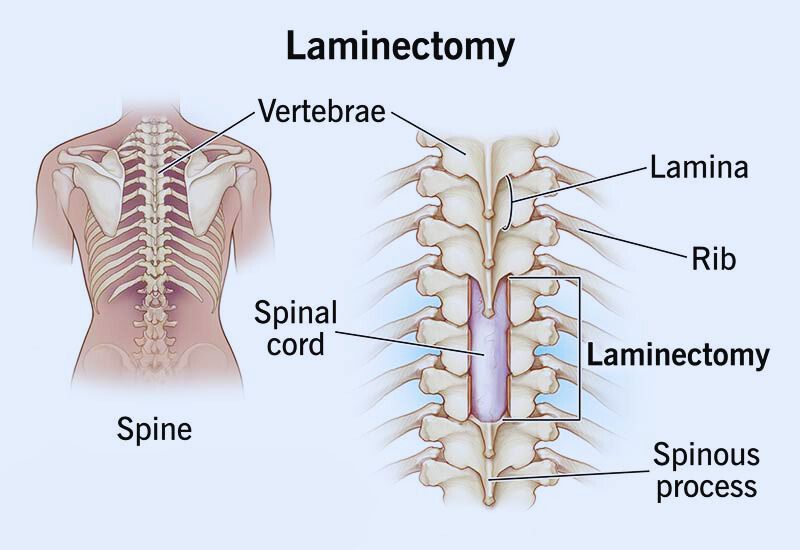How to Manage Cervical Pain:
How to Manage Cervical Pain:5 Effective Methods for Lasting Relief 1. Cervical Pain: An Overview Cervical pain, or neck pain,

A laminectomy is a surgical procedure aimed at alleviating pressure on the spinal cord or nerves by removing a portion of the vertebral bone, known as the lamina. This procedure, often referred to as laminectomy surgery or spinal laminectomy, is typically recommended to address symptoms such as pain, weakness, or numbness in the back or extremities caused by spinal conditions.
The spine comprises a series of vertebrae that protect the spinal cord. The lamina is a thin, bony plate forming the back part of the vertebral arch and serves to cover and safeguard the spinal cord. In certain cases, conditions such as spinal stenosis or injury can necessitate the removal of the lamina to create more space for the spinal cord and nerves, thereby relieving pressure and associated symptoms.
During a laminectomy operation, the patient is placed under general anesthesia. The surgeon makes an incision in the back over the affected area to access the spine. The muscles surrounding the spine are carefully moved aside to expose the lamina. The surgeon then removes the lamina and any other problematic structures, such as bone spurs or damaged tissue, to relieve pressure on the spinal cord and nerves.
Following the removal, the muscles are repositioned, and the incision is closed with stitches or surgical staples. Most patients are monitored in a recovery room for any potential complications and can typically return home the same day or after spending one night in the hospital.
Laminectomy is primarily used to treat conditions that involve pressure on the spinal cord or nerves. One of the most common indications for this procedure is spinal stenosis, a condition where the spinal canal narrows and compresses the spinal cord or nerves. This can lead to pain, numbness, weakness, and difficulty with mobility. Other conditions that might necessitate a laminectomy include herniated discs, spinal tumors, and infections.
The decision to proceed with a laminectomy is made only after non-surgical treatments have been exhausted. These treatments might include physical therapy, pain medication, and steroid injections. The goal is to relieve symptoms and improve quality of life. Laminectomy is generally regarded as a safe and effective treatment, but, like all surgeries, it carries potential risks, including bleeding, infection, nerve damage, and blood clots.
Recovery from laminectomy surgery can vary among individuals. However, most patients can expect to return to their normal activities within a few weeks. It is crucial to adhere to the surgeon’s post-operative care instructions, which often include avoiding heavy lifting and strenuous activities for a period. Physical therapy may be recommended to help strengthen back muscles and enhance mobility.
In summary, a laminectomy, or spinal laminectomy, is a significant surgical procedure aimed at alleviating pressure on the spinal cord or nerves by removing part of the vertebral bone known as the lamina. It is particularly effective for treating conditions such as spinal stenosis, herniated discs, and spinal tumors. With appropriate post-operative care and rehabilitation, most patients experience considerable improvement in their symptoms and quality of life. As with any surgical intervention, discussing the potential risks and benefits with a qualified medical professional is essential to making an informed decision.
For expert consultation and effective relief from spinal issues, reach out to One Spine. Our Best spine surgeons are dedicated to providing comprehensive care for conditions requiring a laminectomy. Whether you’re dealing with spinal stenosis, herniated discs, or other spine-related issues, the experienced team at One Spine is here to guide you through every step of your recovery journey.
Thanks For Read
Also Read : Best Spine Surgeon in Andheri for Effective Neck Pain Relief
How to Manage Cervical Pain:5 Effective Methods for Lasting Relief 1. Cervical Pain: An Overview Cervical pain, or neck pain,
What is Spinal stenosis - Symptoms and causes & Treatment Spinal stenosis occurs when the space within the spine becomes
Spondylosis (Cervical) – Symptoms, Causes and Treatment Cervical spondylosis, often referred to as arthritis of the neck, describes the wear
Sciatica: Causes, Symptoms, Diagnosis, Treatment & Management A herniated disk is a condition that affects the rubbery cushions, known as
Sciatica: Causes, Symptoms, Diagnosis, Treatment & Management What is sciatica? Sciatica refers to pain that arises from irritation or injury